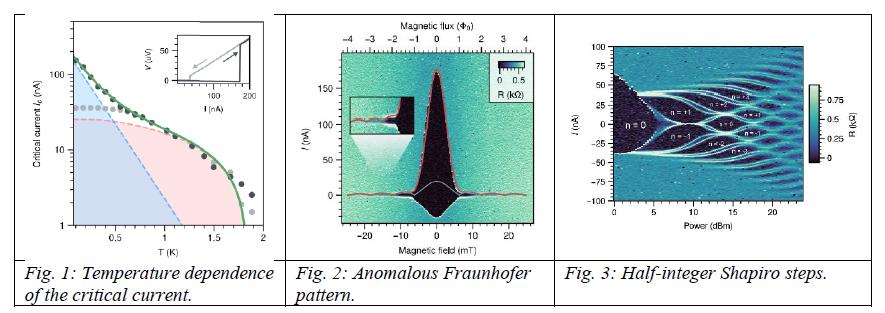Half-integer Shapiro steps in InSb/Nb Josephson junctions
A. Iorio1, B. Turini1, S. Salimian1, M. Carrega2, L. Chirolli1, A. Crippa1, E. Strambini1, V. Zannier1, L. Sorba1, F. Giazotto1, and S. Heun1
1 NEST, Istituto Nanoscienze-CNR and Scuola Normale Superiore, Pisa, Italy
2 CNR-SPIN, Via Dodecaneso 33, 16146 Genova, Italy
InSb is a high-quality narrow band gap semiconductor with strong spin-orbit coupling, which makes it the ideal platform to develop architectures able to coherently induce new states of matter with topological properties when proximitized with superconductors. Here we present transport data on hybrid Josephson junctions made from InSb nanoflags with Nb contacts. The InSb nanoflags have a typical length 2.8 μm, width 500 – 700 nm, and thickness 100 nm. A mobility of 29.500 cm2/(Vs) at an electron density of 8.5 × 1011 cm-2 is measured, which results in an electron mean free path ℓ𝑒 ~ 500 nm [1]. At variance to previous work [1-3], in the junctions presented here the Nb is directly deposited on the S-passivated InSb nanoflags.
The junction discussed in this presentation has a length L of 80 nm and a width W of 700 nm. Since ℓ𝑒>𝐿, the transport in the junction is ballistic. The Nb has a critical temperature of ~ 8.9 K. This corresponds to a BCS gap of ~ 1.3 meV, so that the induced superconducting coherence length exceeds L, which places the device in the short-junction limit. At 30 mK, the junction shows a critical current above 100 nA. The temperature dependence of the critical current above 500 mK is well described by a short-junction model with excellent interface transparency 0.8. However, a detailed analysis of the full temperature range suggests that the current in the junction flows in both a short and a long channel regime, the latter characterized by a path length of about 5 μm (Fig. 1). This result is consistent with the quantitative analysis of the anomalous Fraunhofer pattern measured on the same junction (Fig. 2). Finally, irradiating the junction with microwaves, half-integer Shapiro steps are observed (Fig. 3), which are robust in temperature and persist up to 1 K. Possible explanations for these observations will be discussed in the seminar.

[1] I. Verma et al., ACS Appl. Nano Mater. 4, 5825 (2021).
[2] S. Salimian et al., Appl. Phys. Lett. 119, 214004 (2021).
[3] B. Turini et al., Nano Lett. 22, 8052 (2022).
Helpful discussions with Michal Nowak are gratefully acknowledged. Furthermore, we acknowledge funding by the FET-OPEN project AndQC (H2020 Grant No. 828948) and the EU’s Horizon 2020 research and innovation program under Grant Agreement No. 800923 (SUPERTED) and No. 964398 (SUPERGATE).